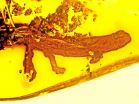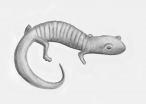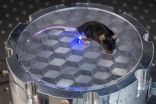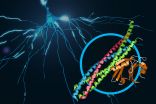(Press-News.org) CORVALLIS, Ore. - More than 20 million years ago, a short struggle took place in what is now the Dominican Republic, resulting in one animal getting its leg bitten off by a predator just before it escaped. But in the confusion, it fell into a gooey resin deposit, to be fossilized and entombed forever in amber.
The fossil record of that event has revealed something not known before - that salamanders once lived on an island in the Caribbean Sea. Today, they are nowhere to be found in the entire Caribbean area.
The never-before-seen and now extinct species of salamander, named Palaeoplethodon hispaniolae by the authors of the paper, adds more clues to the ecological and geological history of the islands of the Caribbean. Findings about its brief life and traumatic end - it was just a baby - have been published in the journal Palaeodiversity, by researchers from Oregon State University and the University of California at Berkeley.
"I was shocked when I first saw it in amber," said George Poinar, Jr., a professor emeritus in the OSU College of Science, and a world expert in the study of insects, plants and other life forms preserved in amber, all of which allow researchers to reconstruct the ecology of ancient ecosystems.
"There are very few salamander fossils of any type, and no one has ever found a salamander preserved in amber," Poinar said. "And finding it in Dominican amber was especially unexpected, because today no salamanders, even living ones, have ever been found in that region."
This fossil salamander belonged to the family Plethodontidae, a widespread family that today is still very common in North America, particularly the Appalachian Mountains. But it had back and front legs lacking distinct toes, just almost complete webbing with little bumps on them. As such, it might not have been as prolific a climber as some modern species, Poinar said, and it probably lived in small trees or tropical flowering plants.
This specimen, Poinar said, came from an amber mine in the northern mountain range of the Dominican Republic, between Puerto Plata and Santiago.
"The discovery of this fossil shows there once were salamanders in the Caribbean, but it's still a mystery why they all went extinct," Poinar said. "They may have been killed by some climatic event, or were vulnerable to some type of predator."
Also a mystery, he said, is how salamanders got there to begin with. The physical evidence suggests the fossil represents an early lineage of phethodon salamanders that evolved in tropical America.
This fossil is 20-30 million years old, and its lineage may go back 40-60 million years ago when the Proto-Greater Antilles, that now include islands such as Cuba, Jamaica, Puerto Rico and Hispaniola, were still joined to North and South America. Salamanders may have simply stayed on the islands as they began their tectonic drift across the Caribbean Sea. They also may have crossed a land bridge during periods of low sea level, or it's possible a few specimens could have floated in on debris, riding a log across the ocean.
Such findings, Poinar said, help both ecologists and geologists to reconstruct ancient events of the Earth's history.
"There have been fossils of rhinoceroses found in Jamaica, jaguars in the Dominican Republic, and the tree that produced the Dominican amber fossils is most closely related to one that's native to East Africa," Poinar said. "All of these findings help us reconstruct biological and geological aspects of ancient ecosystems."
INFORMATION:
Irvine, Calif., August 17, 2015 - A woman's weight at birth, education level and marital status pre-pregnancy can have repercussions for two generations, putting her children and grandchildren at higher risk of low birth weight, according to a new study by Jennifer B. Kane, assistant professor of sociology at the University of California, Irvine. The findings are the first to tie social and biological factors together using population data in determining causes for low birth weight.
"We know that low-birth-weight babies are more susceptible to later physical and cognitive ...
A miniature device that combines optogenetics - using light to control the activity of the brain - with a newly developed technique for wirelessly powering implanted devices is the first fully internal method of delivering optogenetics.
The device dramatically expands the scope of research that can be carried out through optogenetics to include experiments involving mice in enclosed spaces or interacting freely with other animals. The work is published in the Aug. 17 edition of Nature Methods.
"This is a new way of delivering wireless power for optogenetics," said ...
Two Florida laws, enacted to combat prescription drug abuse and misuse in that state, led to a small but significant decrease in the amount of opioids prescribed the first year the laws were in place, a new study by Johns Hopkins Bloomberg School of Public Health researchers suggests.
One measure created a Prescription Drug Monitoring Program, a database that tracks individual prescriptions, including patient names, dates and amounts prescribed, so physicians can be on the lookout for excesses associated with addiction and illicit use. Another addresses so-called "pill ...
Children with parents or caregivers currently serving in the military had a higher prevalence of substance use, violence, harassment and weapon-carrying than their nonmilitary peers in a study of California school children, according to an article published online by JAMA Pediatrics.
While most young people whose families are connected to the military demonstrate resilience, war-related stressors, including separation from parents because of deployment, frequent relocation and the worry about future deployments, can contribute to struggles for some of them, according ...
Menlo Park, Calif. -- Scientists have revealed never-before-seen details of how our brain sends rapid-fire messages between its cells. They mapped the 3-D atomic structure of a two-part protein complex that controls the release of signaling chemicals, called neurotransmitters, from brain cells. Understanding how cells release those signals in less than one-thousandth of a second could help launch a new wave of research on drugs for treating brain disorders.
The experiments, at the Linac Coherent Light Source (LCLS) X-ray laser at the Department of Energy's SLAC National ...
Adversity during the first six years of life was associated with higher levels of childhood internalizing symptoms, such as depression and anxiety, in a group of boys, as well as altered brain structure in late adolescence between the ages of 18 and 21, according to an article published online by JAMA Pediatrics.
Both altered brain structure and an increased risk of developing internalizing symptoms have been associated with adversity early in life.
Edward D. Barker, Ph.D., of King's College London, and coauthors examined how adverse experiences within the first six ...
Legislative efforts by the state of Florida to reduce prescription drug abuse and diversion appear to be associated with modest decreases in opioid prescribing and use, according to an article published online by JAMA Internal Medicine.
Prescription opioids provide necessary pain relief to millions of Americans but rates of opioid diversion, addiction and overdose deaths have soared since the mid-2000s. Florida was at the epicenter of this problem. In 2010, the Florida legislature addressed so-called pill mills or rogue pain management clinics where prescription drugs ...
Presymptomatic patients with the neurodegenerative disease amyotrophic lateral sclerosis (ALS) consumed more daily calories but had lower body-mass index (BMI) than those individuals without ALS in a study in the Netherlands that also looked at risk for the disease and associations with food and alcohol intake, according to an article published online by JAMA Neurology.
The cause of ALS is poorly understood. Diet is highly modifiable but previous studies have not identified a consistent nutrient that modifies susceptibility to ALS and contradictory results exist for the ...
Prior to the advent of human-caused global warming in the 19th century, the surface layer of Earth's oceans had undergone 1,800 years of a steady cooling trend, according to a new study. During the latter half of this cooling period, the trend was most likely driven by large and frequent volcanic eruptions.
An international team of researchers reported these findings in the August 17, 2015 issue of the journal Nature Geoscience. The study also indicates that the coolest temperatures occurred during the Little Ice Age--a period that spanned the 16th through 18th centuries ...
CHICAGO --- Some stressful experiences - such as chronic childhood abuse - are so overwhelming and traumatic, the memories hide like a shadow in the brain.
At first, hidden memories that can't be consciously accessed may protect the individual from the emotional pain of recalling the event. But eventually those suppressed memories can cause debilitating psychological problems, such as anxiety, depression, post-traumatic stress disorder or dissociative disorders.
A process known as state-dependent learning is believed to contribute to the formation of memories that ...



